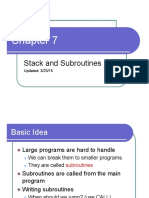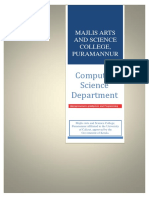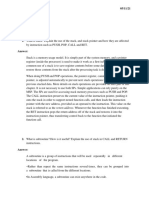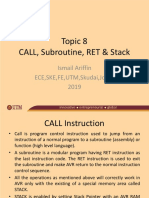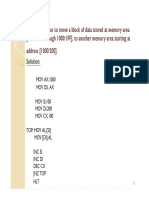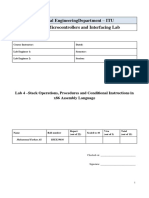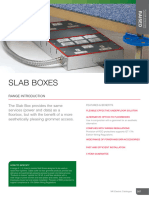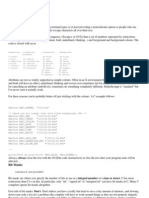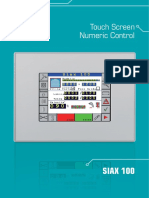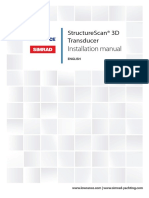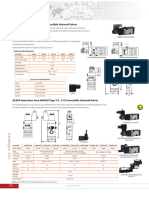1
Chapter 9
Stack and Subroutines
CSE 307- Microprocessor
Mohd. Moinul Hoque,
Lecturer, CSE, AUST
The Stack
The stack is an area of memory identified by the
programmer for temporary storage of information.
The stack is a LIFO structure.
Last In First Out.
The stack normally grows backwards into
memory.
In other words, the programmer
defines the bottom of the stack
and the stack grows up into
reducing address range.
CSE 307- Microprocessor
Memory
The Stack
grows
backwards
into memory
Mohd. Moinul Hoque,
Lecturer, CSE, AUST
Bottom
of the
Stack
The Stack
Given that the stack grows backwards into
memory, it is customary to place the bottom of
the stack at the end of memory to keep it as far
away from user programs as possible.
In the 8085, the stack is defined by setting the
SP (Stack Pointer) register.
LXI SP, FFFFH
This sets the Stack Pointer to location FFFFH
(end of memory for the 8085).
The Size of the stack is limited only by the
available memory
CSE 307- Microprocessor
Mohd. Moinul Hoque,
Lecturer, CSE, AUST
�Saving Information on the Stack
Information is saved on the stack by PUSHing it
on.
It is retrieved from the stack by POPing it off.
The 8085 provides two instructions: PUSH and
POP for storing information on the stack and
retrieving it back.
Both PUSH and POP work with register pairs
ONLY.
CSE 307- Microprocessor
Mohd. Moinul Hoque,
Lecturer, CSE, AUST
�The PUSH Instruction
PUSH B (1 Byte Instruction)
Decrement SP
Copy the contents of register B to the memory
location pointed to by SP
Decrement SP
Copy the contents of register C to the memory
location pointed to by SP
B
12
F3
FFFB
FFFC
FFFD
FFFE
FFFF
CSE 307- Microprocessor
F3
12
SP
Mohd. Moinul Hoque,
Lecturer, CSE, AUST
�The POP Instruction
POP D (1 Byte Instruction)
Copy the contents of the memory location pointed
to by the SP to register E
Increment SP
Copy the contents of the memory location pointed
to by the SP to register D
Increment SP
D
12
F3
FFFB
FFFC
FFFD
FFFE
FFFF
CSE 307- Microprocessor
F3
12
SP
Mohd. Moinul Hoque,
Lecturer, CSE, AUST
�Operation of the Stack
During pushing, the stack operates in a
decrement then store style.
The stack pointer is decremented first, then the
information is placed on the stack.
During poping, the stack operates in a use then
increment style.
The information is retrieved from the top of the the
stack and then the pointer is incremented.
The SP pointer always points to the top of the
stack.
CSE 307- Microprocessor
Mohd. Moinul Hoque,
Lecturer, CSE, AUST
LIFO
The order of PUSHs and POPs must be opposite of each
other in order to retrieve information back into its original
location.
PUSH B
PUSH D
...
POP D
POP B
Reversing the order of the POP instructions will result in
the exchange of the contents of BC and DE.
CSE 307- Microprocessor
Mohd. Moinul Hoque,
Lecturer, CSE, AUST
�The PSW Register Pair
The 8085 recognizes one additional register pair
called the PSW (Program Status Word).
This register pair is made up of the Accumulator
and the Flags registers.
It is possible to push the PSW onto the stack, do
whatever operations are needed, then POP it off
of the stack.
The result is that the contents of the Accumulator
and the status of the Flags are returned to what
they were before the operations were executed.
CSE 307- Microprocessor
Mohd. Moinul Hoque,
Lecturer, CSE, AUST
�PUSH PSW Register Pair
PUSH PSW (1 Byte Instruction)
Decrement SP
Copy the contents of register A to the memory
location pointed to by SP
Decrement SP
Copy the contents of Flag register to the memory
location pointed to by SP
A
Flag
12
80
FFFB
FFFC
FFFD
FFFE
FFFF
CSE 307- Microprocessor
80
12
SP
Mohd. Moinul Hoque,
Lecturer, CSE, AUST
10
�Pop PSW Register Pair
11
POP PSW (1 Byte Instruction)
Copy the contents of the memory location pointed
to by the SP to Flag register
Increment SP
Copy the contents of the memory location pointed
to by the SP to register A
Increment SP
A
Flag
12
80
FFFB
FFFC
FFFD
FFFE
FFFF
CSE 307- Microprocessor
80
12
SP
Mohd. Moinul Hoque,
Lecturer, CSE, AUST
�Modify Flag Content using PUSH/POP
Let, We want to Reset the Zero Flag
7 6 5 4 3 21 0
8085 Flag : S | Z | X |AC|X |P |X |Cy
Program:
LXI SP FFFF
PUSH PSW
POP H
MOV A L
ANI BFH (BFH= 1011 1111)
MOV L A
PUSH H
POP PSW
CSE 307- Microprocessor
* Masking
Mohd. Moinul Hoque,
Lecturer, CSE, AUST
12
�13
Subroutines
A subroutine is a group of instructions that will be
used repeatedly in different locations of the
program.
Rather than repeat the same instructions several
times, they can be grouped into a subroutine that
is called from the different locations.
In Assembly language, a subroutine can exist
anywhere in the code.
However, it is customary to place subroutines
separately from the main program.
CSE 307- Microprocessor
Mohd. Moinul Hoque,
Lecturer, CSE, AUST
�14
Subroutines
The 8085 has two instructions for dealing with
subroutines.
The CALL instruction is used to redirect program
execution to the subroutine.
The RET insutruction is used to return the
execution to the calling routine.
CSE 307- Microprocessor
Mohd. Moinul Hoque,
Lecturer, CSE, AUST
�15
The CALL Instruction
CALL 4000H (3 byte instruction)
When CALL instruction is fetched, the MP
knows that the next two Memory location
contains 16bit subroutine address in the
memory.
2000
2003
CALL 4000
4 0 00
PC
[W] [Z]Register
2003
FFFB
FFFC
FFFD
FFFE
FFFF
CSE 307- Microprocessor
03
20
Mohd. Moinul Hoque,
Lecturer, CSE, AUST
SP
�The CALL Instruction
16
MP Reads the subroutine address from the next
two memory location and stores the higher order
8bit of the address in the W register and stores the
lower order 8bit of the address in the Z register
Pushe the address of the instruction immediately
following the CALL onto the stack [Return
address]
Loads the program counter with the 16-bit address
supplied with the CALL instruction from WZ
register.
CSE 307- Microprocessor
Mohd. Moinul Hoque,
Lecturer, CSE, AUST
�17
The RET Instruction
RET (1 byte instruction)
Retrieve the return address from the top of the
stack
Load the program counter with the return
address.
PC
4014
4015
...
RET
CSE 307- Microprocessor
2003
FFFB
FFFC
FFFD
FFFE
FFFF
03
20
SP
Mohd. Moinul Hoque,
Lecturer, CSE, AUST
�Things to be considered in Subroutine
18
The CALL instruction places the return address
at the two memory locations immediately before
where the Stack Pointer is pointing.
You must set the SP correctly BEFORE using the
CALL instruction.
The RET instruction takes the contents of the two
memory locations at the top of the stack and
uses these as the return address.
Do not modify the stack pointer in a subroutine.
You will loose the return address.
CSE 307- Microprocessor
Mohd. Moinul Hoque,
Lecturer, CSE, AUST
�Things to be considered in Subroutine
Number of PUSH and POP instruction used in
the subroutine must be same, otherwise, RET
instruction will pick wrong value of the return
address from the stack and program will fail.
CSE 307- Microprocessor
Mohd. Moinul Hoque,
Lecturer, CSE, AUST
19
�Passing Data to a Subroutine
20
Data is passed to a subroutine through registers.
Call by Reference:
The data is stored in one of the registers by the calling
program and the subroutine uses the value from the
register. The register values get modified within the
subroutine. Then these modifications will be transferred
back to the calling program upon returning from a
subroutine
Call by Value:
The data is stored in one of the registers, but the
subroutine first PUSHES register values in the stack and
after using the registers, it POPS the previous values of
the registers from the stack while exiting the subroutine.
i.e. the original values are restored before execution
returns to the calling program.
CSE 307- Microprocessor
Mohd. Moinul Hoque,
Lecturer, CSE, AUST
�Passing Data to a Subroutine
21
The other possibility is to use agreed upon
memory locations.
The calling program stores the data in the memory
location and the subroutine retrieves the data from
the location and uses it.
CSE 307- Microprocessor
Mohd. Moinul Hoque,
Lecturer, CSE, AUST
�Cautions with PUSH and POP
PUSH and POP should be used in opposite
order.
There has to be as many POPs as there are
PUSHs.
22
If not, the RET statement will pick up the wrong
information from the top of the stack and the
program will fail.
It is not advisable to place PUSH or POP inside a
loop.
CSE 307- Microprocessor
Mohd. Moinul Hoque,
Lecturer, CSE, AUST
�Conditional CALL and RTE Instructions
23
The 8085 supports conditional CALL and
conditional RTE instructions.
The same conditions used with conditional JUMP
instructions can be used.
CC, call subroutine if Carry flag is set.
CNC, call subroutine if Carry flag is not set
RC, return from subroutine if Carry flag is set
RNC, return from subroutine if Carry flag is not set
Etc.
CSE 307- Microprocessor
Mohd. Moinul Hoque,
Lecturer, CSE, AUST
�A Proper Subroutine
24
According to Software Engineering practices, a
proper subroutine:
Is only entered with a CALL and exited with an
RTE
Has a single entry point
Do not use a CALL statement to jump into different points
of the same subroutine.
Has a single exit point
There should be one return statement from any
subroutine.
CSE 307- Microprocessor
Mohd. Moinul Hoque,
Lecturer, CSE, AUST
�Writing Subroutines
25
Write a Program that will display FF and 11 repeatedly on
the seven segment display. Write a delay subroutine and
Call it as necessary.
C000: LXISP FFFF
C003: MVIA FF
C005: OUT 00
C007: CALL 14 20
C00A: MVIA 11
C00C: OUT 00
C00E: CALL 14 20
C011: JMP 03 C0
DELAY: C014: MVIB FF
C016: MVIC FF
C018: DCR C
C019: JNZ 18 C0
C01C: DCR B
C01D: JNZ 16 C0
C020: RET
CSE 307- Microprocessor
Program Transfer
Mohd. Moinul Hoque,
Lecturer, CSE, AUST












